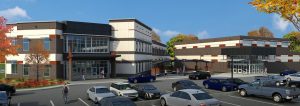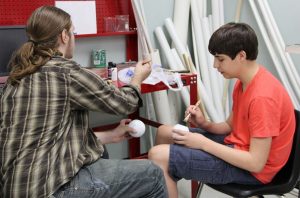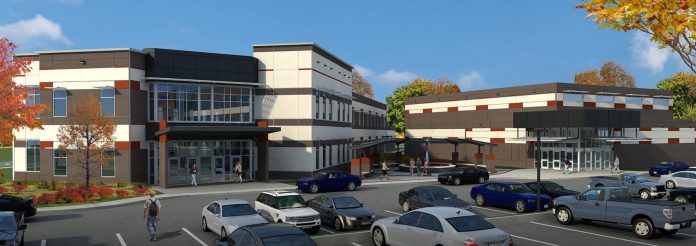
Driving through the section of Lewisville east of I-35E on either side of Corporate Drive, it’s hard to believe amidst the various logistics warehouses and other businesses are two schools.
One is being built from scratch, the other is in the process of converting to meet today’s changing world. Both are part of the Responsive Education Solutions (ResponsiveEd) system of charter schools focused on providing innovative and character-based ways to teach students who learn quite differently from the standard public school methods originally introduced more than 100 years ago.
The new STEM Academy campus, focused on science, technology, engineering and mathematics for students in grades 6-12, is scheduled to open in time for the first classes Aug. 28. It moves from a much smaller building blocks away that will become, in part, the first iSchool High Entrepreneur Academy focused on teaching functional business concepts.
“Because learners are different, we’ve had to be as flexible in our brands and our models as possible,” said Dr. Alan Wimberley, the organization’s chief education architect since 2002. “That’s why we named it Responsive Education Solutions because our role is to go into communities, listen to the communities, listen to the people and their needs, and then pull in the different plans and pieces to create specific models for that community.”
ResponsiveEd started in 1998 with one model – Eagle Academy with 12 high school campuses focused on preventing students from dropping out. With the help of people like Wimberly, it has expended over the past decade to offering multiple educational options in grades K-12.
Today, it now has 73 campuses and growing in Texas and Arkansas and soon in Oklahoma and beyond. It features six school models – Classical Academies, Founders Classical Academies, iSchool High, Quest Middle Schools, Premier High Schools, and iSchool Virtual Academy.
In all, there are 2,330 overall employees with 2,046 of them being teachers and campus faculty. They teach more than 15,000 students on campuses and another 7,000+ online. Nearly 14,000 students have earned diplomas overall.
“We’ve tried to stay below the radar so people don’t realize the scope of what we do and how large we are with nearly 24,000 students now,” Wimberley said.

Charter schools are public schools providing parents with choices on how and where their children are educated. They are funded by federal and state dollars but unlike traditional public school districts receive no local property tax money or facility funds to build buildings. Like at all public schools, students attend for free.
“What the state realized in the 1990s was parents needed to have choices,” Wimberley said. “Private schools said ‘they do have choices.’ That’s fine if they have $12,000-$15,000 a year to pay for tuition so they created the charter school movement.”
“We go to the state of Texas and ask ‘may we open up a certain kind of school in a community.’ That school is considered a public school to where if a parent says ‘I choose that school for my child’ that portion of money that typically goes to the school district goes instead goes to the other public school in town which is the charter school. That portion of money is set aside by the state to educate that child.”
The new ResponsiveEd STEM Academy is being built on four acres of a former empty field. It will feature 56,037 square feet of space at a total cost of $10.3 million and will host about 600 total students – 300 in grades 6-8 and 300 in grades 9-12. They will be overseen by a total faculty and staff of about 40 people. The student-teacher ratio will be no more than 25 to 1.
“We want people to get to Lewisville and see what’s going on over there because we know that we have assembled the brightest and the best staff for that campus like I’ve never seen before,” Wimberley said.
Students will stay in one classroom from 9 a.m. until 1 p.m. with teachers in different core course specialties rotating to assist them. The afternoons will feature more “fun” courses like art and gym and study hall if the students have earned it.
Wimberley said STEM will be “like Socrates in a digital classroom.” All the curriculum and sources are delivered online so that rather than a student learning from lectures and presentations by one person, it’s delivered online where multiple sources are available including college professors and tutors.
The Entrepreneurial Academy will bring a similar energetic, vigorous culture but for career preparation. Wimberley said it will focus on the mind of the entrepreneur, the energetic mind of those people who were born to be enterprise owners.
Think Shark Tank but instead of the entrepreneur having to learn the nuances of starting and owning a business on their own, they would learn those things at age 17 and 18.
The Entrepreneurial Academy, which will share the building with a Premier High School campus, will feature pathways including an incubator lab, virtual reality, robotics and a student-operated, revenue-generating public coffee shop. It will have about 75 students at first with an ultimate capacity of 200. It is believed to be the only school in the area to offer certification in the growing virtual reality realm that companies will be using for things like tools, product sales, resumes, etc.
“I tell teachers at the Entrepreneurial Academy which is big-time for those kids ‘you may be the least educated person in the room when it comes to things like virtual reality’ because those kids are digital natives who were born in a different world than you were born into,’” Wimberley said.
“What we’re creating, what we do is teach these educators what the 21st century teachers have to do. It’s not turn on the computer and get out of the way and let the computer do it.
“We’ve always known the best thing in the classroom is the teacher. But what’s happening is the teachers are feeling a little disenfranchised, a little worried that technology is going to replace them. We say ‘no, it’s not going to replace you; it’s going to reposition you to actually do what you wanted to do when you wanted to be a teacher. You can be what you want to be. You can engage to motivate and change the lives of the kids.’ That’s been our focus for the last 10 years.
“Instead of teachers asking ‘did I teach what I was supposed to teach’ which is the wrong answer, the right answer is ‘did everyone I’m responsible for learn what they were supposed to learn today.’ That’s our goal.”










 GIF.gif)







